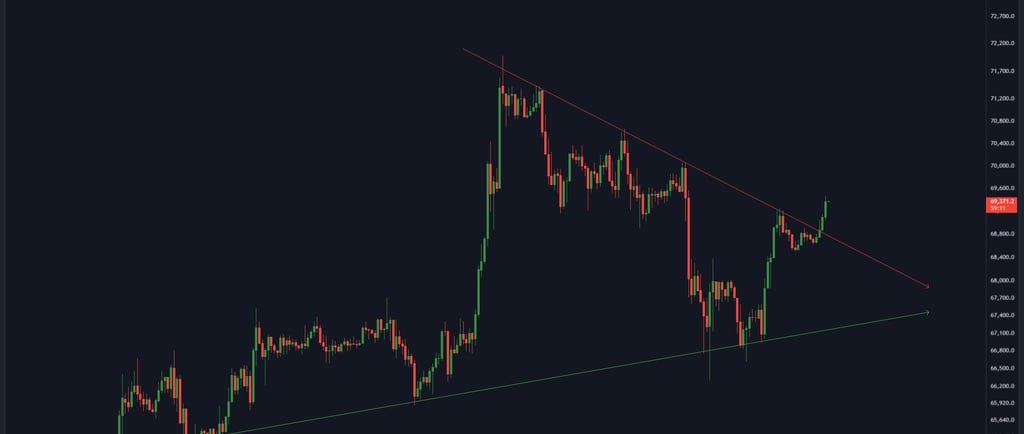Bitcoin Breaks the Downtrend: What’s Next for BTC?
5/25/20243 min read


Analyzing Bitcoin’s Recent Market Performance
Bitcoin's recent market performance has been marked by significant changes, breaking free from a prolonged downtrend. Several key factors have contributed to this shift, including enhanced trading volumes, notable price movements, and impactful events. Over the past few months, Bitcoin saw trading volumes surge, indicating increased investor interest and liquidity. This uptick in trading activity often correlates with price volatility, which has been evident in Bitcoin's market behavior.
One of the primary indicators of Bitcoin's departure from the downtrend has been its price movement. After reaching a low, Bitcoin managed to reclaim critical resistance levels, suggesting robust buying pressure. Technical indicators have further confirmed this trend reversal. The 50-day and 200-day moving averages provided crucial support, and their convergence often signals a bullish trend. The Relative Strength Index (RSI) moved out of the oversold territory, indicating a shift in market momentum towards bullishness. Additionally, the Moving Average Convergence Divergence (MACD) displayed a bullish crossover, reinforcing the positive sentiment.
External factors have also played a crucial role in influencing Bitcoin's market dynamics. Regulatory news, particularly favorable policies in key markets, has contributed to investor optimism. For instance, recent announcements from major economies about clearer cryptocurrency regulations have reduced uncertainties and fostered a more conducive environment for investment. Macroeconomic trends, such as inflation concerns and currency devaluation, have driven investors to seek alternative assets, with Bitcoin being a prime candidate.
Institutional investments have significantly impacted Bitcoin's price action as well. High-profile investments and endorsements from major financial institutions have bolstered market confidence. These developments not only provide validation but also attract retail investors, amplifying market movements.
Expert opinions have largely been optimistic, with many analysts predicting continued growth for Bitcoin. Market sentiment has shifted towards a positive outlook, supported by the technical and fundamental factors discussed. In summary, Bitcoin's recent market performance indicates a strong departure from the downtrend, driven by a combination of technical signals, external influences, and institutional confidence.
Potential Future Scenarios for Bitcoin
Following Bitcoin's recent break from its prolonged downtrend, the market is rife with speculation about its next direction. One potential scenario is a continuation of the uptrend. In this bullish outlook, Bitcoin could see significant gains if it manages to break through key resistance levels, such as the $30,000 and $35,000 marks. Technological advancements like the implementation of the Lightning Network and growing adoption by institutional investors could further bolster this upward momentum. Analysts often cite historical patterns, suggesting that Bitcoin's price cycles tend to follow a 'boom and bust' pattern, and we may be entering a new 'boom' phase.
However, a bearish scenario cannot be overlooked. Despite the recent uptick, Bitcoin faces several obstacles that could lead to a pullback. Key support levels to monitor include the $20,000 and $18,000 ranges. Factors that could trigger a reversal include regulatory crackdowns, adverse macroeconomic conditions, or a shift in investor sentiment. For instance, rising interest rates or geopolitical tensions could diminish risk appetite, prompting a sell-off in Bitcoin and other cryptocurrencies.
Expert forecasts are varied, with some analysts predicting that Bitcoin could reach new all-time highs, while others caution about potential corrections. Analytical models, such as the Stock-to-Flow model, suggest that Bitcoin's scarcity could drive its value higher over the long term. Meanwhile, historical patterns indicate that Bitcoin often experiences significant volatility, making short-term predictions challenging.
Broader economic conditions also play a crucial role in Bitcoin's market dynamics. Inflation, currency devaluation, and economic instability can drive investors toward Bitcoin as a hedge. Conversely, a strong dollar and stable economic conditions could limit Bitcoin's appeal as an alternative asset. Moreover, geopolitical events, such as conflicts or regulatory changes in key markets, can have immediate and profound impacts on Bitcoin's price.
For traders and investors, navigating the current market requires a balanced approach. Keeping an eye on key resistance and support levels, staying informed about technological advancements, and monitoring broader economic indicators can provide valuable insights. Diversification and risk management strategies are essential to mitigate potential losses while positioning for potential gains.
